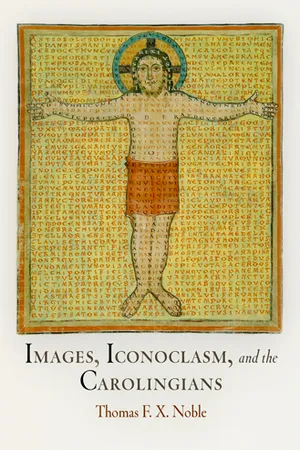
- 496 pages
- English
- PDF
- Available on iOS & Android
Images, Iconoclasm, and the Carolingians
About This Book
In the year 726 C.E., the Byzantine emperor Leo III issued an edict declaring images to be idols, forbidden by Exodus, and ordering all such images in churches to be destroyed. Thus commenced the first wave of Byzantine iconoclasm, which ran its violent course until 787, when the underlying issues were temporarily resolved at the Second Council of Nicaea. In 815, a second great wave of iconoclasm was set off, only to end in 842 when the icons were restored to the churches of the East and the iconoclasts excommunicated.The iconoclast controversies have long been understood as marking major fissures between the Western and Eastern churches. Thomas F. X. Noble reveals that the lines of division were not so clear. It is traditionally maintained that the Carolingians in the 790s did not understand the basic issues involved in the Byzantine dispute. Noble contends that there was, in fact, a significant Carolingian controversy about visual art and, if its ties to Byzantine iconoclasm were tenuous, they were also complex and deeply rooted in central concerns of the Carolingian court. Furthermore, he asserts that the Carolingians made distinctive and original contributions to the whole debate over religious art. Images, Iconoclasm, and the Carolingians is the first book to provide a comprehensive study of the Western response to Byzantine iconoclasm. By comparing art-texts with laws, letters, poems, and other sources, Noble reveals the power and magnitude of the key discourses of the Carolingian world during its most dynamic and creative decades.
Frequently asked questions
Information
Table of contents
- Cover
- Contents
- Introduction
- CHAPTER ONE: Art, Icons, and Their Critics and Defenders Before the Age of Iconoclasm
- CHAPTER TWO: Byzantine Iconoclasm in the Eighth Century
- CHAPTER THREE: Art and Art Talk in the West in the First Age of Iconoclasm
- CHAPTER FOUR: The Franks and Nicaea: Opus Caroli Regis
- CHAPTER FIVE: Tradition, Order, and Worship in the Age of Charlemagne
- CHAPTER SIX: The Age of Second Iconoclasm
- CHAPTER SEVEN: Art and Argument in the Age of Louis the Pious
- CONCLUSION
- NOTES
- BIBLIOGRAPHY
- INDEX
- ACKNOWLEDGMENTS